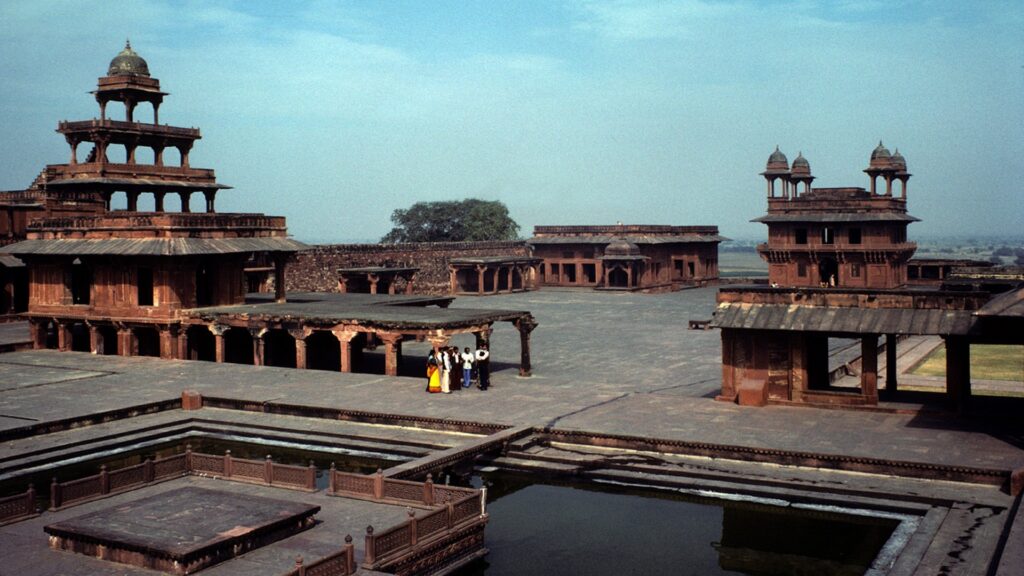Fatehpur Sikri: A Chronicle of Grandeur and Abandonment
Tucked away on the outskirts of Agra, Fatehpur Sikri is a silent reminder of the power of the Mughal era and the passing of time. This architectural wonder was commissioned in the sixteenth century by Emperor Akbar, who wanted a new capital that would represent both administrative prowess and religious harmony. Let’s explore the history of Fatehpur Sikri, including how it was built, why it fell into disuse, and the ghosts of the past that nevertheless adhere to its red sandstone walls.
Building Wonder: Akbar’s Dream City
Known for his inclusive policies and inventive style of government, Emperor Akbar aimed to make Fatehpur Sikri a representation of his secular values. The city quickly took shape, exhibiting a fusion of Timurid, Indian, and Persian architectural styles, after construction started in 1569. Fatehpur Sikri was home to magnificent palaces, beautiful courtyards, and imposing gates made of the region’s characteristic red sandstone. The city was adorned with architectural wonders such as the Panch Mahal, Diwan-i-Khas, and the Jama Masjid.
Jama Masjid: An oasis of spirituality
In the centre of Fatehpur Sikri, the towering Jama Masjid is an example to both architectural genius and religious tolerance. For the various religious communities spread throughout Akbar’s empire, the mosque served as a sacred place with its soaring minarets and large courtyard. The fine marble on top work and finely carved sandstone are evidence to the skill of those previous days.
Renowned for his fascination with diverse religious doctrines, Emperor Akbar had a particular fondness for the Jama Masjid. It is said that he would personally participate in prayers here on a regular basis and hold spiritual conversations with academics and religious authorities. The emperor went to the mosque for comfort and a chance to commune with God because of its imposing architecture and ethereal spiritual atmosphere.
Diwan-i-Khas: Hall of Private Audience
The Diwan-i-Khas, or Hall of Private Audience, showcased Akbar’s commitment to fostering dialogue and understanding among people of different faiths. The central pillar, often referred to as the “Ashoka Pillar,” displayed Akbar’s interest in diverse religious philosophies. The hall itself, adorned with richly carved pillars and a magnificent central platform, served as a space for private discussions and intellectual exchange.
Water Scarcity: The Sustainability Challenge
In accordance to a widely accepted theory, Fatehpur Sikri experienced acute water scarcity. Many water features found in the city’s elaborate architecture, including fountains, pools, and wells, needed a steady and ample supply of water. The decision to leave the city in favour of a more sustainable location is thought to have been prompted by the area’s incapacity to meet these water demands.



Panch Mahal: A Incredible Breeze
The five-story Panch Mahal, which has an open pavilion atop, is an example of Mughal architectural skill. The emperor and his queens used this beautiful building as a place to rest. A cool breeze could be felt during the heat of the summer due to the open design, which gave each level a different view of the surroundings.
Abandonment: The Mystery That Reveals
Fatehpur Sikri’s reign as capital was brief, despite its wealth. The historical reasons for the city’s abandonment are still up for debate. Some blame it on the lack of water, while others say it’s because of strategic and political factors. The fact remains that Fatehpur Sikri was abandoned just fifteen years after it was built.



Buland Darwaza: The Heavenly Gate
Rising as a monument to glory, the Buland Darwaza is one of Fatehpur Sikri’s most recognisable buildings. Accompanied by elaborate carvings and inscriptions, this magnificent gateway was built to celebrate Akbar’s victory over Gujarat. Both the military power and cultural diversity of the Mughal Empire are reflected in the enormous structure.
Anup Talao: The Royal Pond
The Anup Talao, a central platform surrounded by a scenic reservoir, served as a venue for musical performances and intellectual discourses. The elegant pavilions surrounding the pond added to the city’s charm, providing a peaceful retreat for the emperor and his court.
Preservation Efforts: Protecting Heritage
In 1986, Fatehpur Sikri was inducted into the UNESCO World Heritage List as a result of its historical and cultural importance. An attempt to preserve and restore the site have been ongoing, with a focus on maintaining the architectural integrity and ensuring that future generations can witness the splendor of Akbar’s dream city.
Experience for Visitors: A Journey Through Time
Today, travellers and history lovers from all over the world come to Fatehpur Sikri. Travel back in time is encouraged by the weathered walls, silent courtyards, and deserted royal residences. The buildings made of red sandstone tell stories of a time when emperors dreamed of utopian cities and art and governance coexisted in harmony.
With its magnificent architecture and legends of a fleeting splendour, Fatehpur Sikri serves as a sobering reminder of the transience of power and the unpredictable path of history. Even though Akbar’s grandiose and inclusive dream city was abandoned, its influence lives on. Fatehpur Sikri is more than just a city stuck in time; it is a representation of the hopes, hardships, and ambitions of an empire that aimed to cross religious and cultural barriers. Travellers become a part of a story that bounces with the footsteps of emperors and the whispers of a city that once stood at the crossroads of history as they move through its empty streets and investigate its silent palaces.
